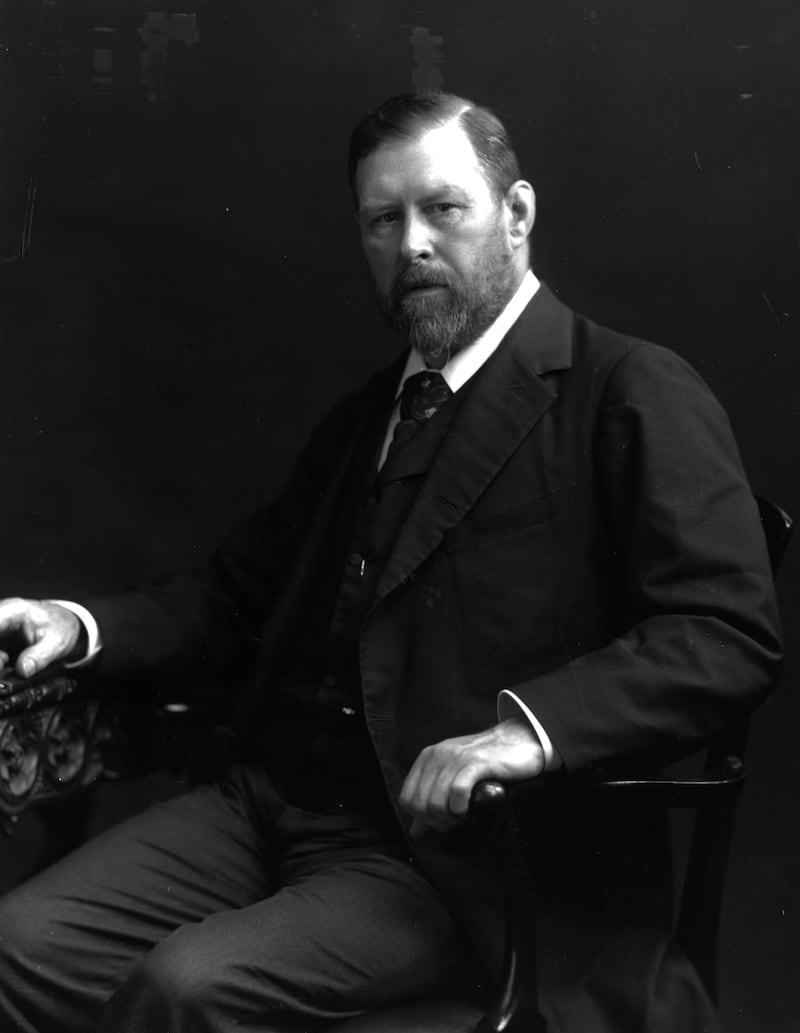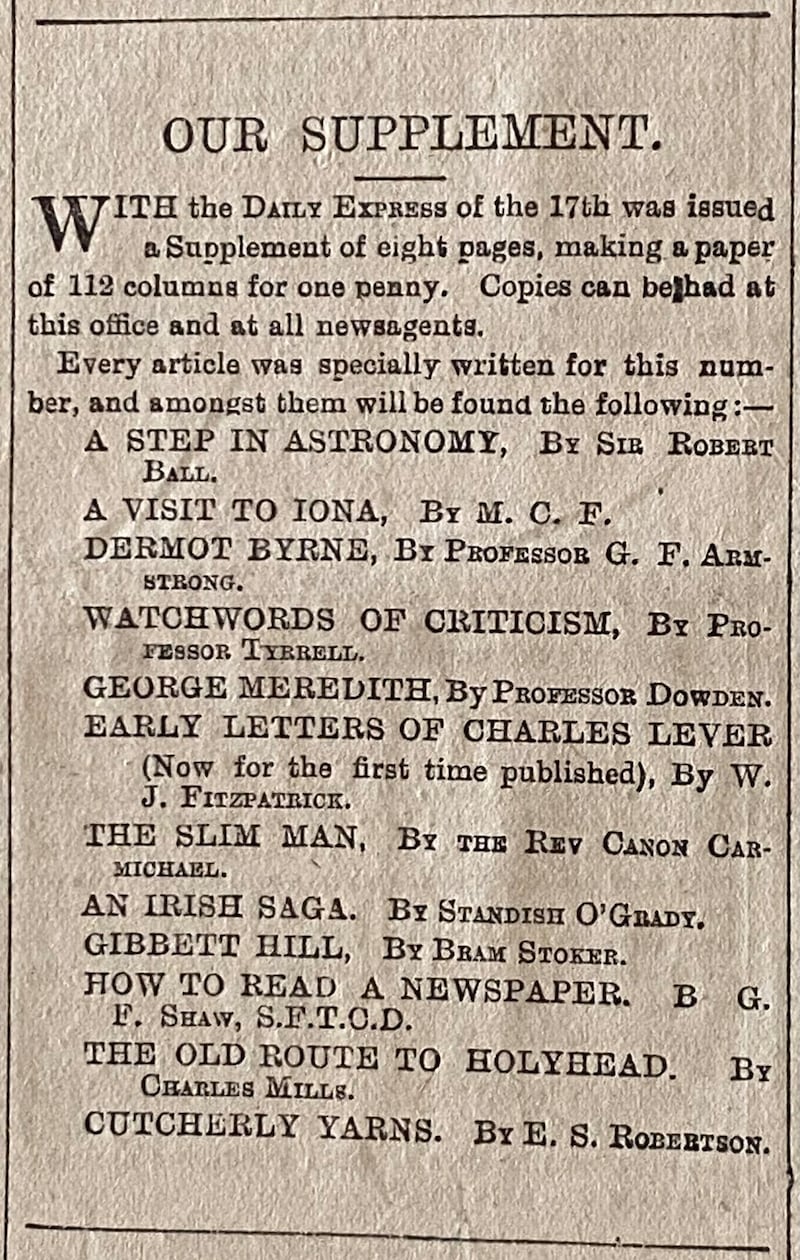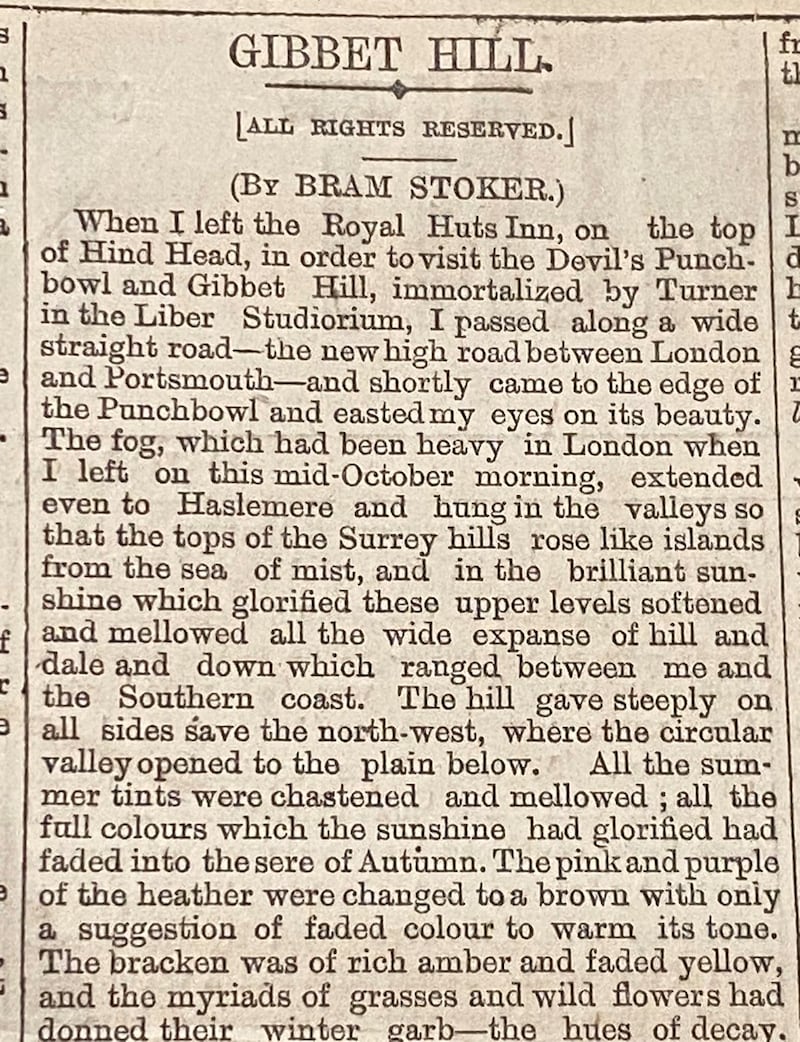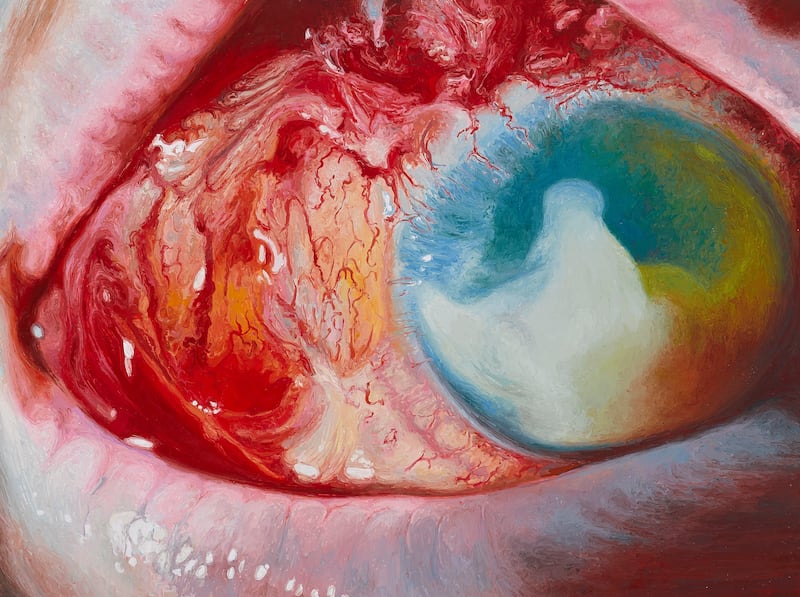On October 12th, 2023 Brian Cleary discovered a lost Bram Stoker story at the National Library of Ireland. That story, Gibbet Hill, was published in a Christmas supplement of the Daily Express’s Dublin edition on December 17th, 1890. It has never been collected or mentioned in Stoker scholarship. Cleary was probably the first person to see it for more than a century.
What did Cleary think when he found it? He laughs. “You’re in this Victorian setting, reading this story from the time that that building was built, and it brings you back to that world. There’s a creepiness and a weirdness to it.”
He shows me a text he sent his wife: “Just found a lost Bram Stoker ghost story with echoes of some elements of Dracula.” This was accompanied by a head-exploding emoji and responded to with an open-mouth emoji. (Dracula, incidentally, is one of the first literary characters to get his own emoji.)
Gibbet Hill, which is being unveiled as part of this year’s Dublin City Council Bram Stoker Festival, is the macabre tale of a man set upon by three strange children at the site of a real-life murder on Gibbet Hill in Surrey, south of London. How Cleary ended up finding it is a scary story in itself. On St Stephen’s Day 2021 he woke up deaf in one ear.
READ MORE
On Christmas Day my daughter played In the Bleak Midwinter on the piano, and I played guitar with her. Then we watched The Royle Family, and the Half the World Away theme came on. Those were the last two pieces of music I heard in stereo. I woke the next morning, zero hearing at all on the left.”

He was prescribed antibiotics for an ear infection but within a week it was clear something more serious was happening, and Cleary was given steroids. It was too late. His hearing didn’t return. A thousand people in Ireland suffer sudden hearing loss each year. (Sometimes it can be addressed if caught early.) Ninety per cent of cases are unexplained. Worse for Cleary than the deafness was the roaring tinnitus. As his brain tried to cope with the lack of signal from his deaf ear, it filled the gap with white noise. This would be in direct proportion to the loudness of sound in his good ear.
“It was like a hairdryer,” Cleary says. It affected his work. It affected his love of music. It was in danger of affecting his relationships.
“I had to go down to a four-day week because of the auditory fatigue of trying to hear everybody,” he says. “I work in the Rotunda [maternity hospital, in Dublin], so at times you’re up in the baby unit, there’s alarms going off and babies crying. Important information is being exchanged. I was able to function fine by getting into the right position and having very understanding, very helpful colleagues.
[ The quiet epidemic of hearing loss in IrelandOpens in new window ]
“But it led to severe auditory fatigue. So you get home in the evening, fall asleep, and then you’re lying on the couch with an Apple noise-suppressing earphone in your good ear, to stop the tinnitus from happening in your bad ear. It would get so loud by the end of the day.” Later he says, “It’s amazing what people can adapt to ... It’s possible to have good times with bad tinnitus. Life goes on.”
Cleary is a born researcher. He spent his extra weekly day off combing through literature on hearing loss and eventually discovered that some who lost hearing and suffered from tinnitus got relief from cochlear-implant surgery. This surgery was being carried out on the public system in Germany; Cleary made the case to the HSE that he should be able to avail of it under the EU’s treatment-abroad scheme. The HSE agreed.
He had surgery in November 2022 and the implant was activated on January 3rd, 2023. When the German doctor spoke into his ear that day, “it was like someone speaking down a Wavin pipe – but I could hear him.” And the tinnitus? “The tinnitus disappeared.” Cleary says, simply, “Cochlear ear implants have transformed my life.”

He took a year off to recover and to retrain his ear. He had a blog, Noisy Silence, in which he wrote about his experiences and through which he met others who had experienced sudden hearing loss. Towards the end of his time off work he began going into the National Library every day to research a historical novel involving Stoker and other real-life characters. Cleary lives in Marino, in north Dublin, and has a bit of an obsession with Stoker, who was born in Marino Crescent.
After three and a half weeks of “systemic searching” for Stoker’s name in the British Newspaper Archive, he found an advertisement in the Dublin Daily Express of New Year’s Day 1891 for a previously published Christmas supplement. The ad listed the authors and stories in the supplement; on the list was “Gibbett Hill by Bram Stoker”. Cleary had never heard of it. He found the supplement and the story itself. This had not come up in his search, which is probably why it went undiscovered. “You have to read the ads,” he says.
[ Paul Simon says he is ‘beginning to’ accept his hearing lossOpens in new window ]
He called up the original newspaper at the NLI – “the excitement of this quiet room with church-like noises, and you just want to tell the people around you, ‘Look what I found!’”
Cleary looked into the literature on Stoker and couldn’t find any reference to Gibbet Hill. He approached Paul Murray, author of From the Shadow of Dracula: The Life of Bram Stoker, who had uncovered lost Stoker stories himself. He “verified that I wasn’t dreaming and this was a legit find. He was amazed that it’s been here and been lost for so long.”

I ask Murray about the context in which the story was written. “The very first notes for Dracula date from March 1890, and this story was published in December 1890,” he says. “My gut feeling is it was written in the autumn of 1890. This is a man with the early Dracula very much on his mind. In the context of the broad sweep of Stoker’s fiction it does become quite important. I have been saying for years Dracula didn’t come out of nowhere. There’s an arc in his fiction which starts with his early stories in the 1870s.”

Are there similarities between Gibbet Hill and Dracula? “There’s a lot of language that’s replicated in both,” Murray says. “There’s also something omnipresent in Stoker: the idea of good and evil being embodied in a particular place, like Castle Dracula.” The poet Lord Tennyson had a house near Gibbet Hill, “and his wife, Emily, thought there was a ‘vampire quality’ in the air of the area that sucked the life out of everyone”. There’s also the “idea of evil being very malicious and destructive and kind of pointless.” The children in the story menace the narrator. They touch his eyeball with a knife. “It seems to be pure evil. It’s a very Stokerian story, you might say.”
Cleary thinks the idea must have come to Stoker when he visited Tennyson earlier that year with Henry Irving, Stoker’s theatre-impresario boss. “Tennyson had just got a phonograph, and they were playing a recording of The Charge of the Heavy Brigade at Balaclava,” his poem about the military action during the Crimean War in 1854. “That recording is still available on the BBC website,” Cleary says, adding that they would have passed Gibbet Hill.
Stoker has written that Irving fell asleep in the carriage beside him. “Bram’s looking out the window and maybe sees the Sailor’s Stone, which is the commemoration of the murder of a sailor at that point 100 years previously. The three murderers were caught, and they got stuck up on a fairly famous gibbet. There was lots of local lore that the stone is haunted, and [Stoker] might have been told about that by the driver.”
Cleary also enlisted another Marino resident, the artist Paul McKinley, who produced a series of evocative artworks inspired by the story. These are currently on show at the Casino in Marino, in an exhibition called Péisteanna. Without giving too much away, these images include a gibbet, worms and a bloodshot eye. “There was so much in it I could work with,” McKinley says. “It was atmospheric in its oddness ... It was a unique opportunity. Nobody had read it, but nobody had visualised it, either. It was a real draw to be the first to respond to it.”

Gibbet Hill is being published as a book on October 26th, with an introduction by Roddy Doyle, an essay by Murray, an essay by Cleary, McKinley’s artwork and a piece written in 1863 by Bram Stoker’s mother, Charlotte, arguing for more state assistance for deaf children. Her commitment to deaf people has understandable resonance for Cleary. All proceeds of the book go to the newly established Charlotte Stoker Fund, administered by the Rotunda Foundation and dedicated to researching and preventing deafness in vulnerable infants.
Cleary is still elated by his discovery and its coming at the end of a very difficult period in his life. “I went deaf and then I found this as a consequence of it,” he says. “There’s a little bit of meaning in it ... I’ve been in [the NLI] with a hard copy of that paper. It’s insane. Someone in the 1890s put that away, and it’s been there for 130 years.”
Gibbet Hill is available from rotundafoundation.ie/gibbet-hill. A public reading takes place, as part of Dublin City Council Bram Stoker Festival, on Saturday, October 26th, at the Pillar Room at the Rotunda Hospital, followed by a panel discussion hosted by Miriam O’Callaghan. Paul McKinley’s Péisteanna is at Casino Marino, Dublin, until Wednesday, November 6th





















